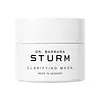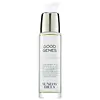What's inside
What's inside
 Key Ingredients
Key Ingredients

 Benefits
Benefits

 Concerns
Concerns

 Ingredients Side-by-side
Ingredients Side-by-side

Water
Skin ConditioningKaolin
AbrasiveAlcohol Denat.
AntimicrobialCetearyl Alcohol
EmollientSimmondsia Chinensis Seed Oil
EmollientLactobacillus/Portulaca Oleracea Ferment Extract
AntioxidantOctyldodecanol
EmollientBrassica Campestris Sterols
EmollientCetearyl Glucoside
EmulsifyingPanthenol
Skin ConditioningZinc PCA
HumectantAllantoin
Skin ConditioningLens Esculenta Seed Extract
Skin ProtectingEchium Plantagineum Seed Oil
Skin ConditioningHelianthus Annuus Seed Oil Unsaponifiables
EmollientSodium Hyaluronate
HumectantPolygonum Bistorta Root Extract
Skin ConditioningLeuconostoc/Radish Root Ferment Filtrate
AntimicrobialCardiospermum Halicacabum Flower/Leaf/Vine Extract
Skin ConditioningTocopherol
AntioxidantXanthan Gum
EmulsifyingMagnesium Aluminum Silicate
AbsorbentSodium Cetearyl Sulfate
CleansingAlcohol
AntimicrobialEthylhexylglycerin
Skin ConditioningCaprylic/Capric Triglyceride
MaskingDisodium EDTA
Hexylene Glycol
EmulsifyingArginine
MaskingAscorbyl Palmitate
AntioxidantPantolactone
HumectantCaprylyl Glycol
EmollientCitric Acid
BufferingAscorbic Acid
AntioxidantPhenoxyethanol
PreservativeCI 77891
Cosmetic ColorantWater, Kaolin, Alcohol Denat., Cetearyl Alcohol, Simmondsia Chinensis Seed Oil, Lactobacillus/Portulaca Oleracea Ferment Extract, Octyldodecanol, Brassica Campestris Sterols, Cetearyl Glucoside, Panthenol, Zinc PCA, Allantoin, Lens Esculenta Seed Extract, Echium Plantagineum Seed Oil, Helianthus Annuus Seed Oil Unsaponifiables, Sodium Hyaluronate, Polygonum Bistorta Root Extract, Leuconostoc/Radish Root Ferment Filtrate, Cardiospermum Halicacabum Flower/Leaf/Vine Extract, Tocopherol, Xanthan Gum, Magnesium Aluminum Silicate, Sodium Cetearyl Sulfate, Alcohol, Ethylhexylglycerin, Caprylic/Capric Triglyceride, Disodium EDTA, Hexylene Glycol, Arginine, Ascorbyl Palmitate, Pantolactone, Caprylyl Glycol, Citric Acid, Ascorbic Acid, Phenoxyethanol, CI 77891
Water
Skin ConditioningOpuntia Tuna Fruit Extract
Skin ConditioningCypripedium Pubescens Extract
Skin ConditioningOpuntia Vulgaris Leaf Extract
Skin ConditioningAgave Tequilana Leaf Extract
AstringentArnica Montana Flower Extract
MaskingAloe Barbadensis Leaf Extract
EmollientSaccharomyces Cerevisiae Extract
Skin ConditioningLeuconostoc/Radish Root Ferment Filtrate
AntimicrobialCaprylic/Capric Triglyceride
MaskingSqualane
EmollientLactic Acid
BufferingPPG-12/Smdi Copolymer
EmollientPropanediol
SolventButylene Glycol
HumectantStearic Acid
CleansingDimethicone
EmollientCetearyl Alcohol
EmollientPhenyl Trimethicone
Skin ConditioningDisiloxane
Skin ConditioningCeteareth-20
CleansingGlyceryl Stearate
EmollientPEG-100 Stearate
Stearyl Glycyrrhetinate
Skin ConditioningGlycyrrhiza Glabra Root Extract
BleachingCymbopogon Schoenanthus Oil
MaskingPotassium Hydroxide
BufferingPhenoxyethanol
PreservativeXanthan Gum
EmulsifyingCaprylyl Glycol
EmollientChlorphenesin
AntimicrobialSodium Phytate
Water, Opuntia Tuna Fruit Extract, Cypripedium Pubescens Extract, Opuntia Vulgaris Leaf Extract, Agave Tequilana Leaf Extract, Arnica Montana Flower Extract, Aloe Barbadensis Leaf Extract, Saccharomyces Cerevisiae Extract, Leuconostoc/Radish Root Ferment Filtrate, Caprylic/Capric Triglyceride, Squalane, Lactic Acid, PPG-12/Smdi Copolymer, Propanediol, Butylene Glycol, Stearic Acid, Dimethicone, Cetearyl Alcohol, Phenyl Trimethicone, Disiloxane, Ceteareth-20, Glyceryl Stearate, PEG-100 Stearate, Stearyl Glycyrrhetinate, Glycyrrhiza Glabra Root Extract, Cymbopogon Schoenanthus Oil, Potassium Hydroxide, Phenoxyethanol, Xanthan Gum, Caprylyl Glycol, Chlorphenesin, Sodium Phytate
 Reviews
Reviews

Ingredients Explained
These ingredients are found in both products.
Ingredients higher up in an ingredient list are typically present in a larger amount.
This ingredient is an emollient, solvent, and texture enhancer. It is considered a skin-softener by helping the skin prevent moisture loss.
It helps thicken a product's formula and makes it easier to spread by dissolving clumping compounds.
Caprylic Triglyceride is made by combining glycerin with coconut oil, forming a clear liquid.
While there is an assumption Caprylic Triglyceride can clog pores due to it being derived from coconut oil, there is no research supporting this.
Learn more about Caprylic/Capric TriglycerideCaprylyl Glycol is a humectant and emollient, meaning it attracts and preserves moisture.
It is a common ingredient in many products, especially those designed to hydrate skin. The primary benefits are retaining moisture, skin softening, and promoting a healthy skin barrier.
Though Caprylyl Glycol is an alcohol derived from fatty acids, it is not the kind that can dry out skin.
This ingredient is also used as a preservative to extend the life of products. It has slight antimicrobial properties.
Learn more about Caprylyl GlycolCetearyl alcohol is a mixture of two fatty alcohols: cetyl alcohol and stearyl alcohol. It is mainly used as an emulsifier. Emulsifiers help prevent the separation of oils and products. Due to its composition, it can also be used to thicken a product or help create foam.
Cetearyl alcohol is an emollient. Emollients help soothe and hydrate the skin by trapping moisture.
Studies show Cetearyl alcohol is non-toxic and non-irritating. The FDA allows products labeled "alcohol-free" to have fatty alcohols.
This ingredient is usually derived from plant oils such as palm, vegetable, or coconut oils. There is debate on whether this ingredient will cause acne.
Due to the fatty acid base, this ingredient may not be Malassezia folliculitis safe.
Learn more about Cetearyl AlcoholLeuconostoc/Radish Root Ferment Filtrate is a natural preservative. It comes from fermenting radish roots with a bacteria called leuconostoc.
Leuconostoc comes from lactic acid.
This ingredient has antimicrobial properties and helps prevent the growth of bacteria in a product.
Leuconostoc is used to make the traditional Korean side-dish, kimchi. It is also used to make sourdough bread (both incredibly yummy foods).
Learn more about Leuconostoc/Radish Root Ferment FiltratePhenoxyethanol is a preservative that has germicide, antimicrobial, and aromatic properties. Studies show that phenoxyethanol can prevent microbial growth. By itself, it has a scent that is similar to that of a rose.
It's often used in formulations along with Caprylyl Glycol to preserve the shelf life of products.
Water. It's the most common cosmetic ingredient of all. You'll usually see it at the top of ingredient lists, meaning that it makes up the largest part of the product.
So why is it so popular? Water most often acts as a solvent - this means that it helps dissolve other ingredients into the formulation.
You'll also recognize water as that liquid we all need to stay alive. If you see this, drink a glass of water. Stay hydrated!
Learn more about WaterXanthan gum is used as a stabilizer and thickener within cosmetic products. It helps give products a sticky, thick feeling - preventing them from being too runny.
On the technical side of things, xanthan gum is a polysaccharide - a combination consisting of multiple sugar molecules bonded together.
Xanthan gum is a pretty common and great ingredient. It is a natural, non-toxic, non-irritating ingredient that is also commonly used in food products.
Learn more about Xanthan Gum